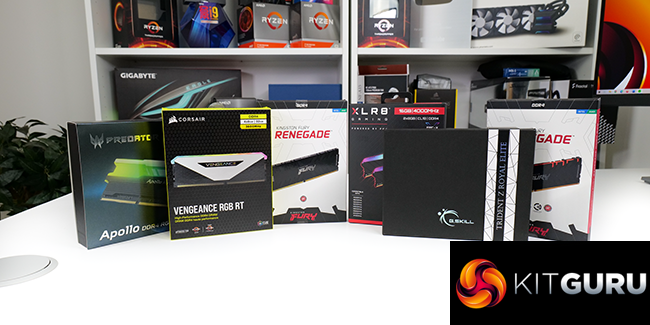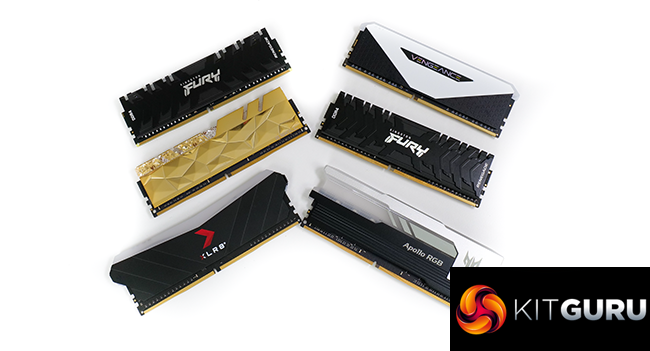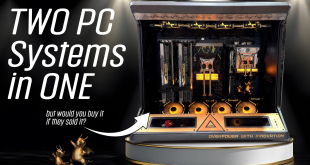There we have a decent summary of a few different kits that we had in for review on our AMD test platform. The key takeaway really does reaffirm what we already anticipated and kind-of knew; dual-rank 32GB 3600MHz sets of memory – preferably with tight timings – perform very well on the AMD platform.
Single-rank 16GB kits continue to serve their purpose from a value perspective, as shown by the PNY XLR8 Gaming EPIC-X RGB set. That’s especially true if you pick a kit that sticks below around 3800MHz so that you do not have to penalise your system by dropping the CPU’s memory controller frequency.
Throughout testing, we really did struggle to see the mindset for using the uber-clocked Kingston Fury Renegade set, even when running at a ludicrous 4600MHz with reasonable timings – which was the best our X570 motherboard could handle.
This looks to be a set of memory better intended for the Intel platform or perhaps some specific synthetic benchmarking records, especially as it is a DDR4 kit offering DDR5 speeds. So we will keep an eye on this set for use with Intel’s upcoming 12th Gen Alder Lake CPUs, as that could deliver an interesting comparison between DDR4 and DDR5 at roughly equivalent memory clocks.
To close out, it is good to see a premium kit from Predator that has the ability to compete against G.SKILL’s ultra-premium Trident Z Royal Elite set in terms of performance. The G.SKILL kit is still the best truly high-end option from this round-up’s participants in our opinion, especially as the overall design is smarter and more relevant. But UK availability continues to be dire, and the suggested pricing is incredibly steep.
The more reasonably priced Corsair and Kingston 32GB 3600MHz sets are what we’d lean towards for a more sensible build. The Corsair Vengeance RGB RT kit offers a very well-finished product at a sensible price, but the stock timings are loose and this does hurt performance on occasions when combined with the lesser performing Samsung (probably not B-die) memory ICs.
Kingston’s Fury Renegade RGB impressed us overall. It was rarely the very fastest set in the chart, but the Hynix-based modules performed well, the operating voltage was sensible, and the RGB implementation is a bit different to many of the competitors. Couple the strong UK pricing, and this does look like a stellar option.
Our overall feeling towards the PNY XLR8 Gaming EPIC-X RGB 16GB 4000MHz kit is that it is simply OK. Performance is OK, aside from the instances where the AMD platform penalises 4000MHz memory. The RGB implementation is not very good and certainly leaves a lot to be desired. But the price tag of a little under £110 in the UK is very competitive versus other 4GHz RGB modules, so I guess that’s where the value argument lies.
This has been an interesting look at some different memory kits, their designs, and then the performance for varying DDR4 specifications on the AMD platform. If you want to see something similar for the upcoming Intel platform with DDR4 and DDR5 compatibility, be sure to let us know in the comment section down below.
Discuss on our Facebook page HERE.
Predator Apollo RGB DDR4
Pros:
- Strong performance
- Optimal frequency and timings
- Good lighting design
- Excellent build quality
Cons:
- Excessively tall
KitGuru says: The Predator Apollo RGB DDR4 kit offers strong performance alongside a stellar lighting display.
Corsair Vengeance RGB RT
Pros:
- Excellent aesthetic design
- Sensible heatsink size and construction
- Superb lightbar implementation
- Temperature sensor is useful
- Great iCUE coordination
Cons:
- Performance is lacking, especially with the loose timings
KitGuru says: Corsair has ticked the aesthetics and lighting box convincingly with the Vengeance RGB RT in white. The timings are loose, but the price point is reasonable.
G.SKILL Trident Z Royal Elite
Pros:
- Outstanding performance out of the box
- Headroom to overclock to 3800MHz for the AMD platform
- RGB LED lighting continues to be unique
- Heatsink design is very premium
- Temperature sensor is useful
Cons:
- Very expensive in the US and basically non-existent in the UK
KitGuru says: The G.SKILL Trident Z Royal Elite kit is ultra-premium and ultra-expensive. The excellent performance from Samsung B-die ICs perhaps justifies the price tag, but good luck finding a kit on sale in the UK.
Kingston Fury Renegade RGB 3600MHz 32GB
Pros:
- Good, hassle-free performance out of the box
- Headroom to overclock to 3800MHz for the AMD platform
- Different approach to RGB lighting and heatsink design – subtle on the lighting
- Build quality is fantastic
- Very competitive UK pricing
Cons:
- Kingston Fury CTRL software through Windows Store is unwelcomed
KitGuru says: I like the Kingston Fury Renegade RGB memory set that we tested a lot. The kit does not necessarily excel in any particular area, but its balance between performance, understated design, and cost make it a very real contender.
Kingston Fury Renegade 5333MHz 16GB
Pros:
- Obscenely high frequency capability, if you have an appropriate use case
- Stellar heatsink design to handle 1.6V
- Plenty of flexibility for overclocking when memory speed headroom is required
- Dual XMP configurations is a smart move
Cons:
- Ludicrously expensive
- Overkill for most use cases
- High-speed, single-rank will often struggle versus sensible-speed, dual-rank
- Compatibility even with modern motherboards and platforms is limited
KitGuru says: Kingston’s ludicrously expensive and high-speed kit is a showcase of what the company can offer. This makes little sense on the AMD platform, especially as even the high-end boards are unlikely to run the kit at 5333MHz. But we will keep our eye out for an opportunity to test the memory on the Intel 12th Gen platform with direct head-to-head against DDR5.
PNY XLR8 Gaming EPIC-X RGB
Pros:
- Cheap and effective performance
- Well-priced for an RGB kit
- Out-of-the-box specifications are good
Cons:
- RGB lighting implementation is very poor
KitGuru says: The PNY XLR8 Gaming EPIC-X RGB kit that we tested offers good bang-for-the-buck, even if the RGB lighting implementation is particularly poor. Budget buyers will likely be impressed by the level of performance offered up from a sub-£110 RGB memory kit.
 KitGuru KitGuru.net – Tech News | Hardware News | Hardware Reviews | IOS | Mobile | Gaming | Graphics Cards
KitGuru KitGuru.net – Tech News | Hardware News | Hardware Reviews | IOS | Mobile | Gaming | Graphics Cards







